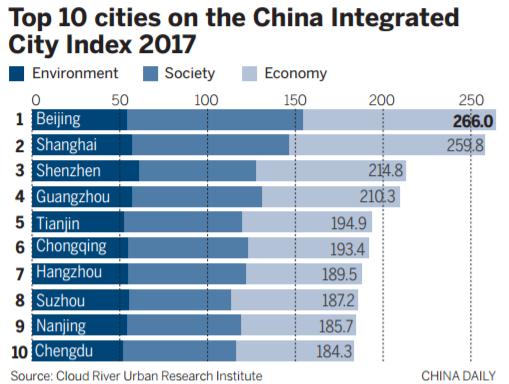
Take Beijing for example. The city ranked the top under the index of society for its capital status, international influence, quality of cultural and entertainment life and consumption level that no other cities can compare with.
But in some sub-indexes of society, the capital city had a weak performance. For instance, Beijing ranked 169 under the index of population growth rate, 294 under the index of traffic safety and 290 under the index of housing price to income ratio.
Chongqing is another interesting city. As an economic center and transportation hub in Southwest China, the city ranked sixth in the overall ranking. However, Chongqing is the only city among the top 30 that had population outflows.
In addition, the China Integrated City Index 2017 introduced the concept of densely inhabited district (DID) to reflect the trend of centralized and clustered urban development in China. The concept of DID refers to districts with a population density of more than 5,000 inhabitants per square kilometer.
The index reflected that DID population has a high correlation with a city's ability to attract talent and industrial resources, and high-quality DID area is the foundation of the development of modern cities.
For example, the top 30 cities account for 40 percent of the country's total GDP, 89.7 percent of Fortune 500 Chinese companies, 67.2 percent of the country's listed companies on the main board and 80.7 percent of the country's total imports of goods.
This set of data reflected the overwhelming advantages of China's megacities in terms of economic development level, innovation and entrepreneurship, Zhou said, noting that the high-quality urban clusters will be a crucial driving force of China's urbanization process.
The government already launched a series of policies to boost the development of three major urban areas-the Beijing-Tianjin-Hebei region, the Yangtze River Delta and the Pearl River Delta.
Xu Lin, director of China Center for Urban Development affiliated with the NDRC, said high-quality growth requires high-quality urbanization and there are many urgent issues that deserve attention of the policymakers and need to be resolved.
The issues include disorderly expansion and inefficient use of urban space, unreasonable layout of infrastructure networks, lack of openness and inclusiveness of cities and lack of scientific and forward-looking approaches in urban planning, according to Xu.


















































